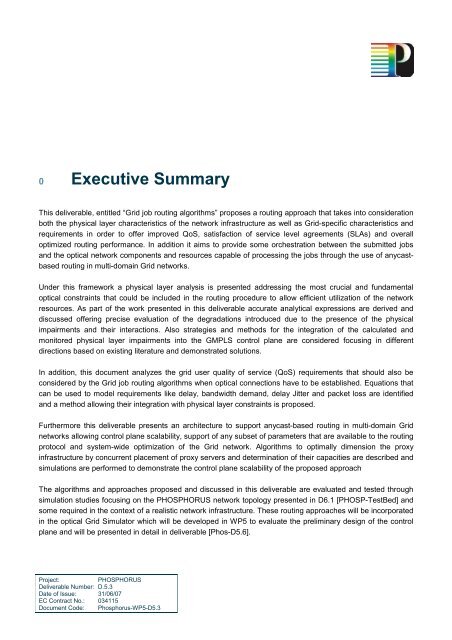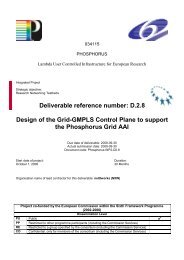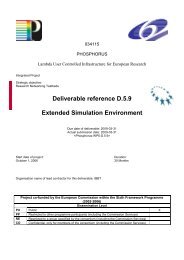Grid Job Routing Algorithms - Phosphorus
Grid Job Routing Algorithms - Phosphorus
Grid Job Routing Algorithms - Phosphorus
Create successful ePaper yourself
Turn your PDF publications into a flip-book with our unique Google optimized e-Paper software.
0 Executive SummaryThis deliverable, entitled “<strong>Grid</strong> job routing algorithms” proposes a routing approach that takes into considerationboth the physical layer characteristics of the network infrastructure as well as <strong>Grid</strong>-specific characteristics andrequirements in order to offer improved QoS, satisfaction of service level agreements (SLAs) and overalloptimized routing performance. In addition it aims to provide some orchestration between the submitted jobsand the optical network components and resources capable of processing the jobs through the use of anycastbasedrouting in multi-domain <strong>Grid</strong> networks.Under this framework a physical layer analysis is presented addressing the most crucial and fundamentaloptical constraints that could be included in the routing procedure to allow efficient utilization of the networkresources. As part of the work presented in this deliverable accurate analytical expressions are derived anddiscussed offering precise evaluation of the degradations introduced due to the presence of the physicalimpairments and their interactions. Also strategies and methods for the integration of the calculated andmonitored physical layer impairments into the GMPLS control plane are considered focusing in differentdirections based on existing literature and demonstrated solutions.In addition, this document analyzes the grid user quality of service (QoS) requirements that should also beconsidered by the <strong>Grid</strong> job routing algorithms when optical connections have to be established. Equations thatcan be used to model requirements like delay, bandwidth demand, delay Jitter and packet loss are identifiedand a method allowing their integration with physical layer constraints is proposed.Furthermore this deliverable presents an architecture to support anycast-based routing in multi-domain <strong>Grid</strong>networks allowing control plane scalability, support of any subset of parameters that are available to the routingprotocol and system-wide optimization of the <strong>Grid</strong> network. <strong>Algorithms</strong> to optimally dimension the proxyinfrastructure by concurrent placement of proxy servers and determination of their capacities are described andsimulations are performed to demonstrate the control plane scalability of the proposed approachThe algorithms and approaches proposed and discussed in this deliverable are evaluated and tested throughsimulation studies focusing on the PHOSPHORUS network topology presented in D6.1 [PHOSP-TestBed] andsome required in the context of a realistic network infrastructure. These routing approaches will be incorporatedin the optical <strong>Grid</strong> Simulator which will be developed in WP5 to evaluate the preliminary design of the controlplane and will be presented in detail in deliverable [Phos-D5.6].Project:PHOSPHORUSDeliverable Number: D.5.3Date of Issue: 31/06/07EC Contract No.: 034115Document Code: <strong>Phosphorus</strong>-WP5-D5.3






